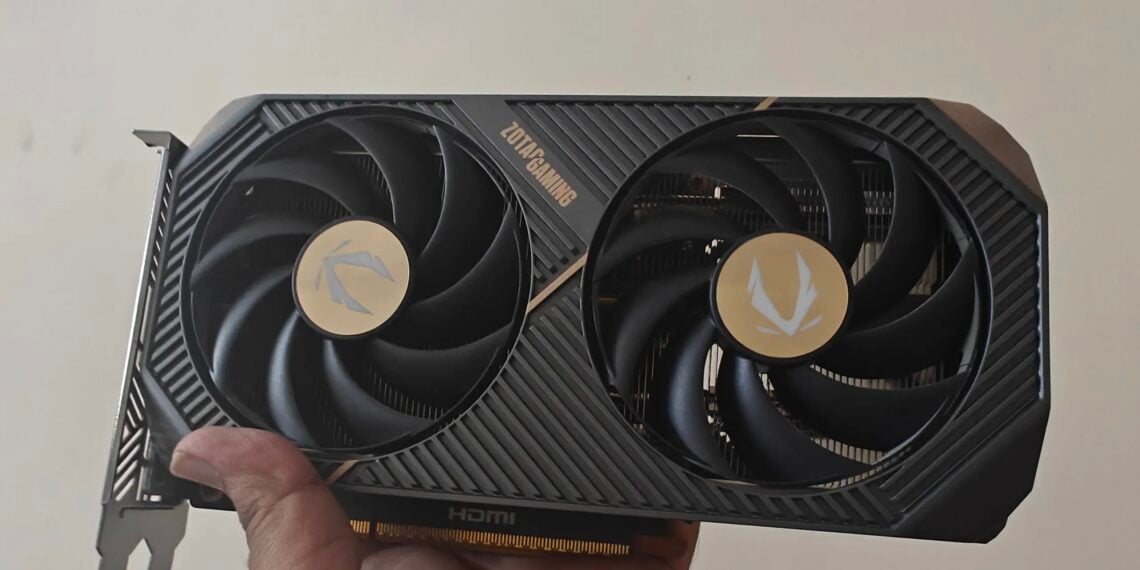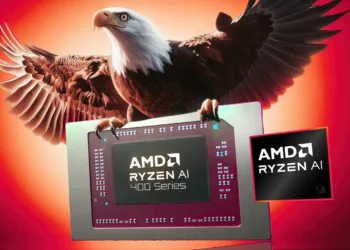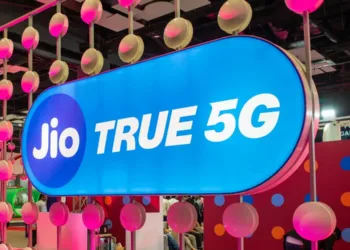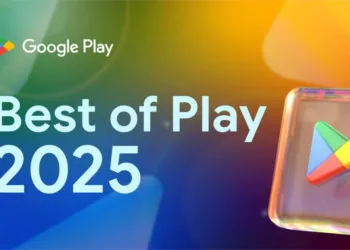The RTX 5060’s 8GB VRAM limitation raises serious questions about 1440p viability, but NVIDIA’s revolutionary DLSS 4 Multi Frame Generation changes the equation dramatically. Here’s what real-world benchmarks reveal about gaming at 2560×1440 on the budget Blackwell GPU.
Table of Contents
The Hardware Reality: Specifications Overview
| Specification | RTX 5060 8GB | Context |
|---|---|---|
| CUDA Cores | 3,840 cores | 25% more than RTX 4060 |
| Memory | 8GB GDDR7 | Same capacity, faster bandwidth |
| Memory Bandwidth | 448 GB/s | 65% faster than RTX 4060 |
| TDP | 160-180W | Efficient Blackwell architecture |
| DLSS Support | DLSS 4 (Multi Frame Gen) | Exclusive to RTX 50 series |
| MSRP | $299 | Budget 1440p contender? |
As detailed in our comprehensive ZOTAC RTX 5060 Twin Edge review, the compact form factor and efficient cooling make this card particularly appealing for small form factor builds, but the question remains: can 8GB VRAM truly handle 1440p gaming in 2025?
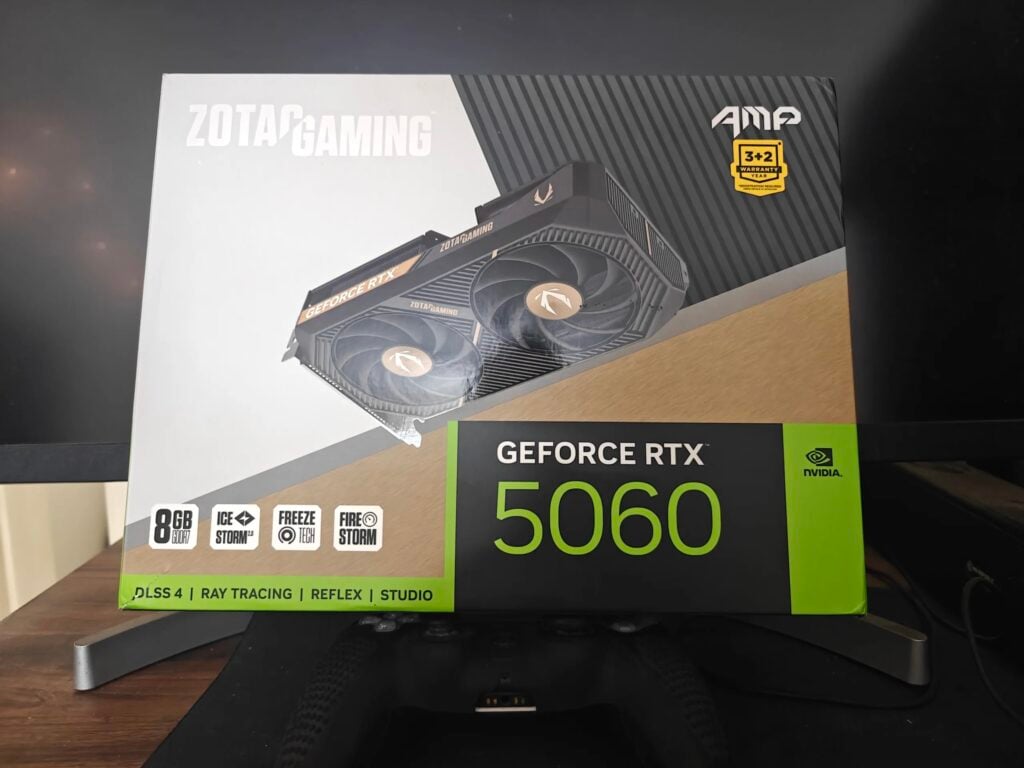
Native 1440p Performance: The Harsh Truth
Rasterized Gaming Without Upscaling
At 1440p, several examples showed where 8GB GPUs began to fall apart. In some cases, performance appeared acceptable, but visual quality suffered due to missing textures that couldn’t fit into local video memory.
AAA Title Performance (1440p Ultra, Native Resolution):
| Game | Average FPS | 1% Low | VRAM Usage | Playability |
|---|---|---|---|---|
| Cyberpunk 2077 | 81 FPS | ~62 FPS | 7.8GB+ | Marginal, near limit |
| Hogwarts Legacy | ~65 FPS | ~52 FPS | 7.5GB | Texture pop-in issues |
| The Last of Us Part I | Inconsistent | Variable | 8GB+ saturated | Frame time problems |
| Dying Light 2 | 62 FPS | ~48 FPS | 7.2GB | Generally stable |
| S.T.A.L.K.E.R. 2 | 6 FPS | Unplayable | VRAM saturated | Completely unviable |
| Star Wars Jedi: Survivor | ~58 FPS | ~45 FPS | 7.8GB | Playable with caveats |
| Red Dead Redemption 2 | 105 FPS | ~82 FPS | 6.8GB | Smooth experience |
The GeForce RTX 5060 and 4060 are poorly suited for 1440p, with many titles delivering unplayable performance due to a VRAM bottleneck or limited shader compute.
The Verdict on Native 1440p: Possible in older or well-optimized titles, but modern AAA games at Ultra settings frequently hit the 8GB VRAM wall, causing stuttering, texture degradation, and inconsistent frame times. Our detailed RTX 5060 testing confirms these VRAM constraints as the primary limitation.

The DLSS 4 Revolution: Multi Frame Generation Changes Everything
What Makes DLSS 4 Different
NVIDIA’s DLSS 4 introduces Multi Frame Generation (MFG), exclusive to RTX 50 series GPUs. Unlike traditional upscaling that renders at lower resolution, MFG uses AI to generate up to 3 additional frames for every rendered frame.
DLSS 4 Components:
- Super Resolution: AI upscaling (also in DLSS 3)
- Ray Reconstruction: Improved RT denoising (also in DLSS 3)
- Multi Frame Generation: NEW – Generates 1-3 frames between rendered frames
- 2x Mode: Generates 1 additional frame (2 total frames per render)
- 4x Mode: Generates 3 additional frames (4 total frames per render)
As we noted in our RTX 5060 review, DLSS 4 represents the biggest advantage this generation brings to budget gaming, fundamentally altering performance expectations.
DLSS 4 Performance Multiplier at 1440p
Using the Balanced preset with DLSS, Cyberpunk 2077 leaps to 164 FPS at 1080p and 137 FPS at 1440p, while Horizon Zero Dawn climbs to 180 FPS and 138 FPS. God of War also benefits significantly, hitting 154 FPS at 1080p and 128 FPS at 1440p.
Cyberpunk 2077 (1440p Performance Scaling):
| Setting | FPS | Performance Gain |
|---|---|---|
| Native Ultra (no DLSS) | 81 FPS | Baseline |
| DLSS Balanced | 137 FPS | +69% improvement |
| DLSS Balanced + MFG 2x | 172 FPS | +112% improvement |
| DLSS Balanced + MFG 4x | 264 FPS | +226% improvement |
DLSS 4 multi frame generation pushes things even further. In Cyberpunk 2077, enabling the RTX 50-series exclusive feature yields 172 FPS at 1440p with the 2x setting, while the 4x mode jumps all the way to 264 FPS.
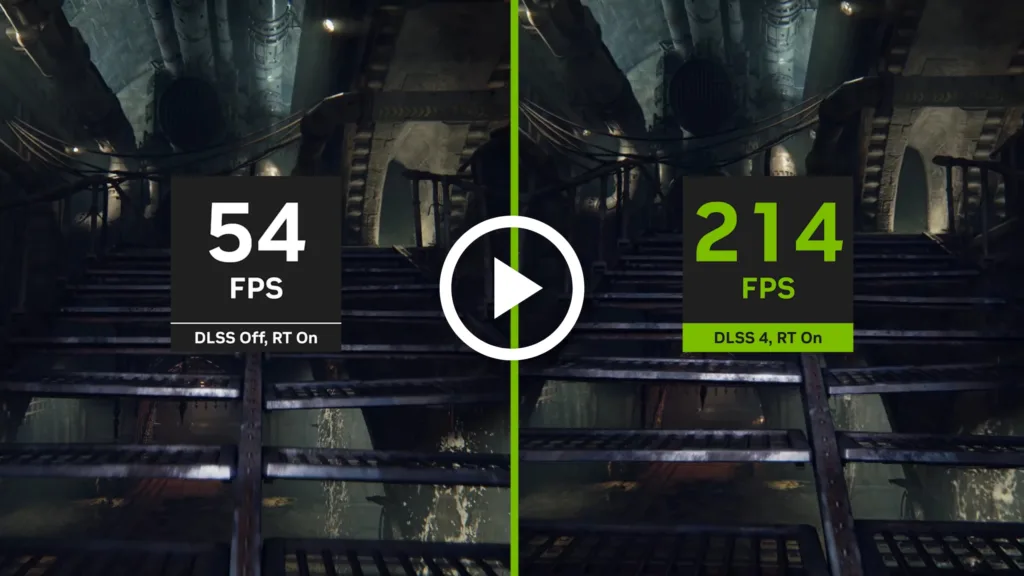
Critical Caveat: Visual Artifacts
Multi frame generation is still in its early stage, meaning you may face visual artifacts like motion blur, ghosting, and sparkling due to the AI algorithm’s interpolation in fast-moving scenes.
When MFG Works Best: ✅ Slower-paced games (RPGs, adventure titles) ✅ High base frame rates (60+ FPS native) ✅ Predictable camera movements ✅ Well-lit scenes with clear edges
When MFG Struggles: ❌ Fast-paced competitive shooters ❌ Rapid camera whip-pans ❌ Particle-heavy effects (explosions, magic) ❌ Very low base frame rates (<30 FPS)
Comprehensive 1440p Gaming Benchmarks
Ray Tracing Performance with DLSS
Ray tracing at 1440p becomes viable exclusively through DLSS assistance:
Black Myth: Wukong (1440p + RT + DLSS Balanced):
| Setting | Average FPS | Notes |
|---|---|---|
| RT Native | ~29 FPS | Unplayable |
| RT + DLSS Balanced | 45 FPS | Playable baseline |
| RT + DLSS + MFG 2x | ~68 FPS | Smooth experience |
| RT + DLSS + MFG 4x | ~95 FPS | High-refresh viable |
Dragon’s Dogma 2 (1440p + RT):
- Native RT: 30 FPS (slideshow)
- DLSS Balanced: 45 FPS (acceptable)
- DLSS + MFG 2x: ~68 FPS (smooth)
- DLSS + MFG 4x: ~98 FPS (excellent)
Esports and Competitive Gaming
At 1080p on Medium, the RTX 5060 saw 370fps on average in Counter-Strike 2—27% faster than the 4060 and matching the RTX 3070. The 1440p result of 370fps likewise outpaced the Radeon 7700XT by a slim margin.
Competitive Title Performance (1440p Medium/High):
| Game | Native FPS | DLSS Quality FPS | Competitive Viability |
|---|---|---|---|
| Counter-Strike 2 | 370 FPS | N/A (not needed) | Excellent |
| Valorant | 280+ FPS | N/A (not needed) | Excellent |
| Apex Legends | 135 FPS | 180+ FPS | Great |
| Call of Duty | 95 FPS | 140+ FPS | Very good |
| Fortnite | 145 FPS | 210+ FPS | Excellent |
Esports Verdict: The RTX 5060 crushes 1440p esports gaming, delivering frame rates well beyond high-refresh monitor capabilities (144Hz-240Hz). As detailed in our full performance analysis, competitive gaming remains this card’s strongest use case.
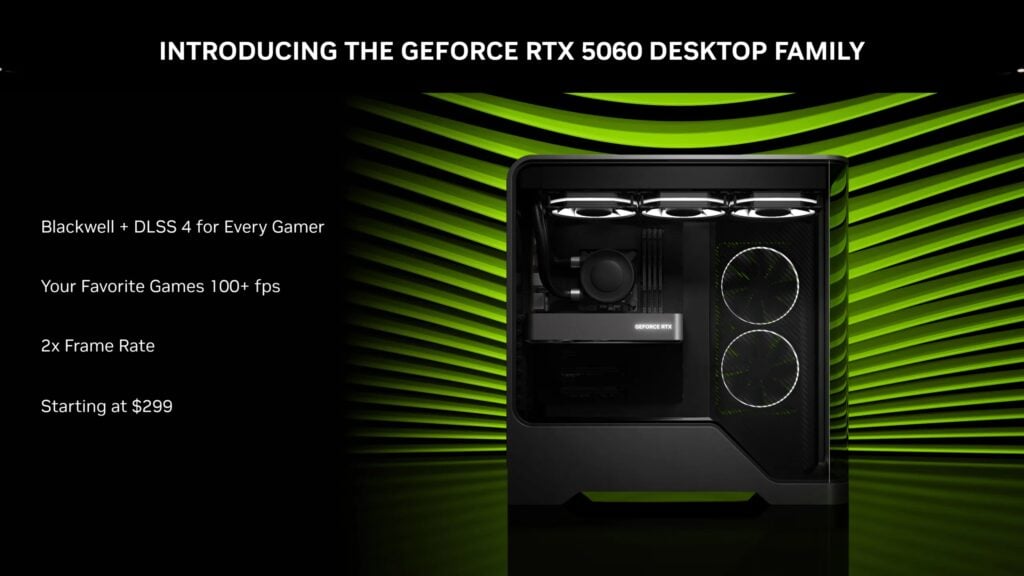
Modern AAA Titles: The VRAM Struggle
Indiana Jones and the Great Circle (1440p): Indiana Jones and the Great Circle only runs satisfactorily on 8GB GPUs using low-quality textures. The RTX 5060 is nearly 60% faster than the RTX 4060, undoubtedly due to its higher bandwidth.
Texture Quality Compromise: Many demanding 2024-2025 titles require dropping texture quality to High or Medium at 1440p to avoid VRAM saturation, even with DLSS enabled.
Games Requiring Texture Reduction:
- Indiana Jones and the Great Circle
- The Last of Us Part I
- S.T.A.L.K.E.R. 2: Heart of Chornobyl
- Alan Wake 2
- Avatar: Frontiers of Pandora
Well-Optimized Titles: Where 1440p Shines
Warhammer 40K: Space Marine 2 (1440p):
- Native Ultra: ~78 FPS
- DLSS Quality: ~105 FPS
- DLSS + MFG 2x: ~145 FPS
- Verdict: Excellent performance with DLSS
Horizon Zero Dawn (1440p):
- Native Ultra: 113 FPS
- DLSS Balanced: 138 FPS
- DLSS + MFG 2x: ~180 FPS
- Verdict: Buttery smooth even without MFG
God of War (1440p):
- Native Ultra: ~98 FPS
- DLSS Balanced: 128 FPS
- DLSS + MFG 2x: ~165 FPS
- Verdict: Premium experience throughout
The VRAM Wall: When 8GB Isn’t Enough
Memory-Intensive Scenarios That Break
If you up settings to 2,560 x 1,440, you already start to bump up against the VRAM limitation, with the memory usage turning red in the graphics menu. Enabling frame gen at these settings saturates the VRAM, with latency going up to 74ms. While the average frame rate of 92fps looks higher with frame gen enabled, the game was actually unplayable in action.
Critical Warning: In VRAM-saturated scenarios, even DLSS 4’s Multi Frame Generation cannot save performance. The system begins swapping to system RAM, creating catastrophic stuttering—a limitation we extensively documented in our RTX 5060 review.
How to Identify VRAM Bottlenecks:
- In-game memory usage warnings turning yellow/red
- Sudden frame time spikes (1% lows crashing)
- Texture pop-in or reduced quality mid-game
- System RAM usage spiking during gameplay
Workarounds for VRAM-Limited Gaming
1. Texture Quality Reduction: Drop textures from Ultra to High or Medium
2. Resolution Scaling: Use DLSS Performance mode (renders at 1080p, displays at 1440p)
3. Close Background Apps: Free every MB of VRAM possible
4. Disable Ray Tracing: RT assets consume substantial VRAM
5. Lower Shadow Quality: Shadows use considerable memory bandwidth
Real-World User Experience: 1440p Daily Gaming
The Ideal RTX 5060 1440p Setup
Monitor: 1440p 144Hz display (optimal pairing) Settings Philosophy: High/Ultra mix with DLSS Quality/Balanced Expectation Management: Accept texture compromises in newest AAA titles
Typical Gaming Session:
- Esports/Competitive: Native 1440p, 200+ FPS consistently
- Single-Player AAA (2022-2023): High/Ultra DLSS Quality, 80-100+ FPS
- Newest AAA (2024-2025): High settings, DLSS Balanced, texture compromises, 60-80 FPS
- Ray Tracing: DLSS + MFG required, expect 60-90 FPS with visual artifacts
Games That Excel on RTX 5060 at 1440p
“Safe Bet” Titles (Confirmed Good Performance):
✅ Counter-Strike 2
✅ Valorant
✅ Apex Legends
✅ Fortnite
✅ Red Dead Redemption 2
✅ Horizon Zero Dawn
✅ God of War
✅ Dying Light 2
✅ Cyberpunk 2077 (with DLSS)
✅ Spider-Man: Miles Morales
✅ Elden Ring
✅ Monster Hunter World
“Proceed with Caution” Titles (VRAM Issues):
⚠️ The Last of Us Part I
⚠️ S.T.A.L.K.E.R. 2
⚠️ Indiana Jones (texture reduction mandatory)
⚠️ Alan Wake 2 (path tracing problematic)
⚠️ Avatar: Frontiers of Pandora
⚠️ Star Wars Outlaws
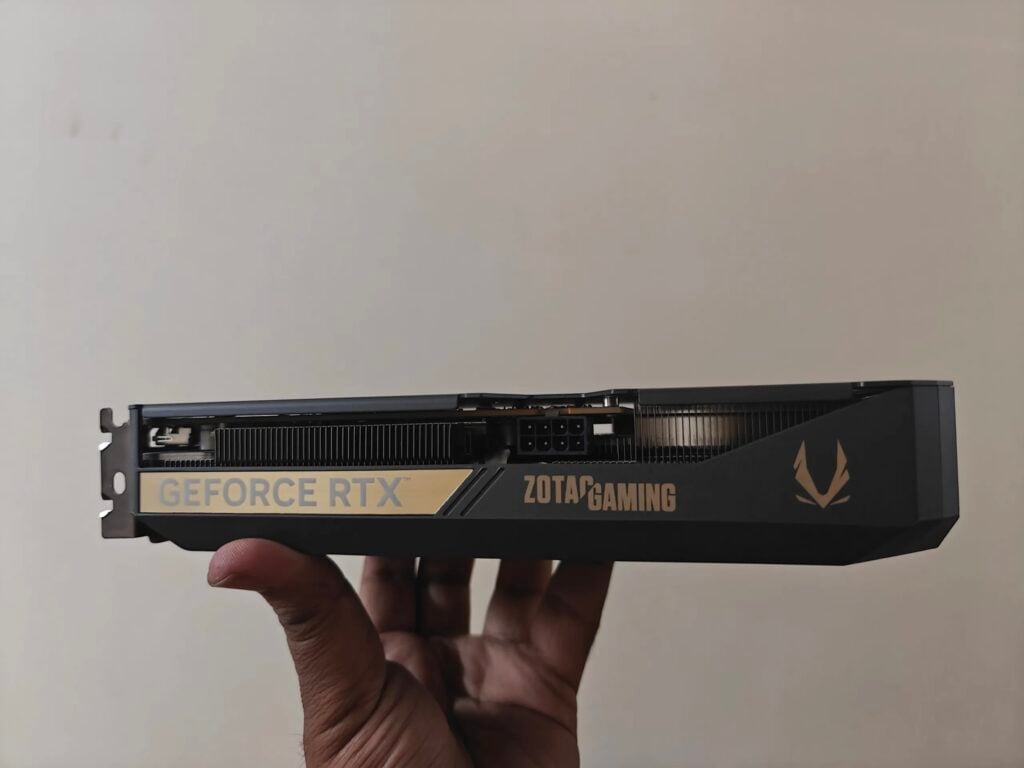
DLSS 4 vs. Competition: AMD FSR 3 and Intel XeSS
Frame Generation Comparison:
| Technology | Max Generated Frames | Latency Impact | Quality | Hardware Req |
|---|---|---|---|---|
| DLSS 4 MFG | 3 frames (4x total) | Low (Reflex integration) | Excellent | RTX 50 series only |
| AMD FSR 3 FG | 1 frame (2x total) | Moderate | Good | Works on all GPUs |
| Intel XeSS | No frame gen | N/A | Very good upscaling | Intel Arc preferred |
DLSS 4’s Advantage: Generating 3 frames vs. competitors’ 1 frame creates performance multipliers unmatched by AMD or Intel solutions currently.
Power Consumption and Thermals at 1440p
System Power Draw:
- 1440p Native Gaming: ~160-180W GPU, ~260-280W total system
- 1440p DLSS Quality: ~150-170W GPU (lower rendering res)
- 1440p DLSS + MFG 4x: ~165-185W GPU (frame gen overhead)
Thermal Performance:
- Gaming Load Average: 62-66°C
- Stress Test Peak: 68-70°C
- Hotspot: ~75-78°C
The RTX 5060 remains thermally comfortable at 1440p, making it suitable for compact cases and quiet builds—particularly with ZOTAC’s efficient Twin Edge cooling solution we praised in our detailed review.
The Verdict: Is 1440p Gaming Viable?
Yes, BUT With Major Caveats
✅ 1440p Gaming Works Well When:
- Playing esports/competitive titles
- Using DLSS Quality or Balanced mode
- Accepting High instead of Ultra textures
- Playing games from 2022 or earlier
- Utilizing DLSS 4 Multi Frame Generation
- Avoiding ray tracing in VRAM-heavy titles
❌ 1440p Gaming Struggles When:
- Playing newest AAA titles at Ultra textures
- Attempting 4K upscaling to 1440p displays
- Running memory-intensive ray tracing
- Maxing out every graphics setting
- Gaming without DLSS support
The DLSS 4 Multiplier Effect
DLSS 4 Multi Frame Generation fundamentally changes the RTX 5060’s 1440p viability. What would be 40-50 FPS borderline experiences transform into 80-120 FPS smooth gameplay through AI frame generation.
Without DLSS 4: RTX 5060 is a 1080p card that struggles at 1440p With DLSS 4: RTX 5060 becomes a capable 1440p gaming GPU with compromises
Who Should Buy RTX 5060 for 1440p?
✅ Ideal Buyers:
- DLSS believers willing to use upscaling
- Primarily esports/competitive gamers
- Single-player gamers accepting texture compromises
- Budget-conscious upgraders from GTX 1060/1070
- Users planning 2-3 year upgrade cycles
❌ Should Look Elsewhere:
- Ultra settings purists
- Players demanding native rendering
- Those building for 4K gaming
- Buyers wanting 5+ year future-proofing
- Content creators needing 8GB+ VRAM
Final Recommendation: The Pragmatic 1440p Choice
The RTX 5060 8GB can absolutely handle 1440p gaming in 2025, but success depends entirely on embracing DLSS 4 and accepting compromises. Native 1440p Ultra settings remain problematic in newest AAA titles due to VRAM limitations, but DLSS Quality mode with Multi Frame Generation unlocks 80-120+ FPS experiences in most games.
The Formula for Success:
- Always enable DLSS (Quality or Balanced)
- Use Multi Frame Generation in supported titles
- Drop texture quality to High in demanding games
- Prioritize frame rate over Ultra settings
- Accept that 8GB limits future-proofing
For $299, the RTX 5060 delivers impressive 1440p gaming when used intelligently. As we concluded in our comprehensive ZOTAC RTX 5060 Twin Edge review, buyers unwilling to compromise should save for the RTX 5060 Ti 16GB or RTX 5070, but those embracing DLSS 4’s AI-powered performance multipliers will find the RTX 5060 a capable—if not perfect—1440p gaming companion.
Rating: 7.5/10 for 1440p Gaming (with DLSS 4 factored in)
For our full RTX 5060 analysis including thermal testing, power consumption, and detailed gaming benchmarks, read our complete ZOTAC RTX 5060 Twin Edge 8GB review. For more GPU reviews and gaming hardware analysis, visit TechnoSports.

